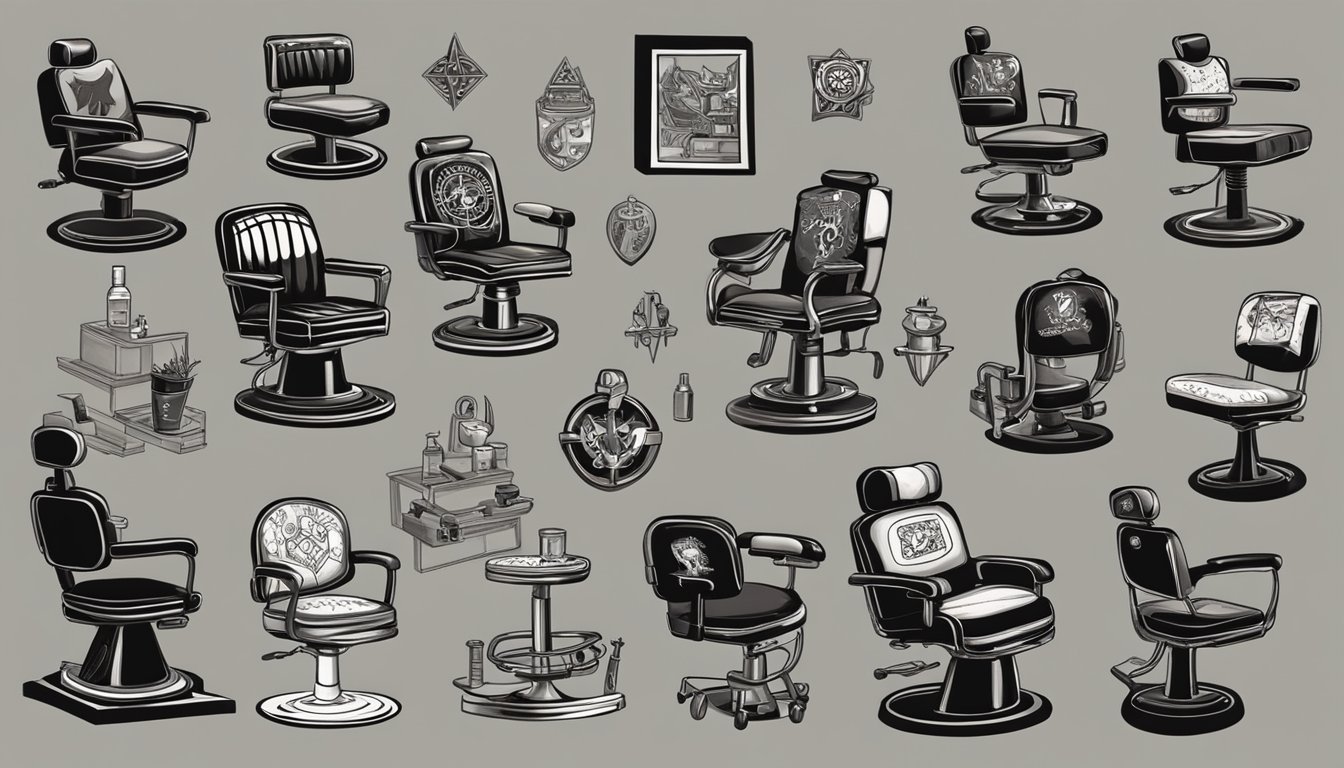The Psychology of Jesse's Tattoos: Ink as Character Development
Breaking Bad's Visual Storytelling
Jesse Pinkman's tattoos in Breaking Bad serve as visual storytelling elements, revealing aspects of his character without a single word spoken. These inked designs complement his persona, carefully chosen during pre-production to enhance the authenticity of his role. Jesse's tattoos function as silent narrators, offering glimpses into his past, personality, and inner turmoil throughout the series.
The psychology behind Jesse's tattoos extends beyond mere aesthetics. Each piece of ink represents a facet of his identity, from his rebellious nature to his hidden vulnerabilities. As the character evolves, his tattoos become anchors to his past self, contrasting with his changing circumstances and moral dilemmas.
Tattoos in media often symbolize deeper psychological themes, and Jesse's are no exception. They reflect his desire for self-expression, his need to belong, and his attempts to assert control over his life. As viewers follow Jesse's journey, his tattoos become familiar landmarks on the map of his character development, adding depth to his portrayal and inviting audience interpretation.
Understanding Jesse Pinkman
Jesse Pinkman's character arc in Breaking Bad is a complex journey of transformation and redemption. His experiences shape him from a small-time drug dealer to a man seeking redemption and a new life.
From Start to Redemption
Jesse begins as Walt's former student and reluctant partner in the meth business. His initial carefree attitude evolves as he faces increasingly traumatic events. The loss of loved ones and exposure to violence take their toll.
By the fifth season, Jesse's desire for redemption becomes clear. He attempts to leave the drug world behind and make amends for past wrongs. His struggles with guilt and search for meaning drive much of his later character development.
Jesse's journey culminates in his escape from captivity and departure from New Mexico, symbolizing his break from his former life.
Complexity of Character
Jesse's character depth stems from his conflicting traits and motivations. He displays streetwise toughness alongside vulnerability and compassion. His loyalty often conflicts with his moral compass.
Jesse's relationships reveal different facets of his personality. With Walt, he shifts from admiration to fear and resentment. His bonds with Jane and Andrea show his capacity for love and desire for normalcy.
Trauma plays a key role in Jesse's development. Each loss and betrayal leaves its mark, contributing to his increasingly haunted demeanor and search for redemption.
Influence of Vince Gilligan
Creator Vince Gilligan's vision shaped Jesse's arc significantly. Gilligan originally planned to kill Jesse in season one but was impressed by Aaron Paul's performance.
This decision allowed Jesse's character to evolve into a central moral compass for the show. Gilligan crafted Jesse's journey to highlight themes of consequence and the possibility of change.
Jesse's transformation from "Cap'n Cook" to a man seeking absolution reflects Gilligan's interest in character growth and moral complexity. His arc provides a counterpoint to Walt's descent, enriching the show's exploration of morality and choices.
Symbolism of Tattoos in Narrative
Tattoos serve as powerful visual symbols in storytelling, conveying deep meaning about characters' identities and personal journeys. They often represent pivotal moments or core aspects of a character's personality.
Celtic Scorpion and Its Meaning
The Celtic scorpion tattoo blends two distinct symbolic elements. In Celtic tradition, spirals and knotwork patterns represent eternity and interconnectedness. The scorpion itself symbolizes protection, survival, and transformation.
This combination creates a complex emblem of enduring strength and adaptability. For a character, it might signify:
Overcoming hardship
Embracing change
Honoring ancestral roots
In narratives, such a tattoo could hint at a character's resilient nature or mark a significant life transition. It might also foreshadow future challenges or personal growth.
Tattoos as Markers of Change
Tattoos often denote important milestones or transformations in a character's arc. They can:
Commemorate pivotal events
Represent new identities or beliefs
Symbolize personal victories or losses
A character might get a tattoo after:
Surviving a near-death experience
Leaving a toxic relationship
Achieving a long-held goal
These permanent marks serve as visual reminders of character development. They allow readers to track a character's evolution throughout the story.
Tattoos can also create intrigue, prompting questions about a character's past or motivations. This adds depth to the narrative and engages readers in the character's journey.
In-Depth Tattoo Analysis
Jesse Pinkman's tattoos serve as visual markers of his character development throughout Breaking Bad. Each design reflects key moments and experiences that shape his journey.
Breaking Down Each Tattoo
Jesse's most prominent tattoo is the scorpion on his right hand. This design symbolizes his dangerous lifestyle and the constant threat he faces. The scorpion's aggressive nature mirrors Jesse's involvement in the criminal underworld.
On his left arm, Jesse sports a tribal-style tattoo. This piece likely represents his desire for belonging and identity within a group, reflecting his complex relationships with various factions throughout the series.
A skull tattoo adorns Jesse's chest, possibly symbolizing his brushes with death and the dark path he's chosen. This macabre image serves as a constant reminder of mortality in his high-risk world.
Connection to Key Plot Points
Jesse's tattoos often align with significant moments in Breaking Bad's narrative. The scorpion tattoo becomes more visible as he delves deeper into the drug trade, emphasizing his growing danger and reputation.
The tribal tattoo gains prominence during Jesse's struggles with addiction and his attempts to find community. It's particularly noticeable in scenes where he grapples with loyalty and betrayal.
His chest tattoo becomes a focal point during emotionally charged moments, especially when Jesse faces life-threatening situations or contemplates the consequences of his actions. This visual cue reinforces the gravity of his choices.
Jesse Pinkman's Relationships
Jesse's connections profoundly shaped his character arc throughout Breaking Bad. His interactions with key figures molded his emotional journey and influenced his decisions.
With Walter White
Jesse and Walter's relationship evolved from teacher-student to partners in crime. Initially, Walt viewed Jesse as a means to an end. Their dynamic shifted as they faced dangers together. Walt's manipulative behavior often left Jesse conflicted and traumatized.
Jesse looked up to Walt as a father figure at times. This admiration faded as Walt's actions grew more ruthless. Their bond became strained by lies, betrayal, and violence. Jesse's guilt over their criminal activities intensified.
Walt's influence pushed Jesse deeper into the drug world. This caused Jesse immense inner turmoil as he struggled with his conscience.
With Jane Margolis
Jesse's romance with Jane marked a turning point in his life. Their relationship offered him a glimpse of normalcy and love. Jane's presence temporarily eased Jesse's guilt and pain.
However, their shared addiction threatened to destroy them both. Jesse's grief after Jane's death haunted him deeply. This loss fueled his spiral into depression and self-destructive behavior.
Jane's death also widened the rift between Jesse and Walt. Jesse blamed himself, unaware of Walt's role in the tragedy.
Impact on Jesse's Psyche
Jesse's relationships left lasting scars on his psyche. His experiences with Walt and Jane intensified his feelings of guilt and self-loathing. Jesse's trauma manifested in nightmares, substance abuse, and erratic behavior.
His interactions with children, like Brock, revealed Jesse's compassionate nature. These moments highlighted the contrast between Jesse's inherent goodness and the criminal world he inhabited.
Jesse's relationships exposed his vulnerability and capacity for empathy. They also demonstrated his resilience in the face of repeated emotional hardships.
Cultural Impact and Reception
Jesse Pinkman's tattoos became a subject of intense fan discussion and analysis. They sparked debates about character development and symbolism in Breaking Bad and El Camino.
Fandom and Reddit Discussions
Reddit threads devoted to Jesse's tattoos gained significant traction. Fans dissected each design, proposing theories about their meanings and connections to plot points. The scorpion tattoo on Jesse's hand drew particular attention, with viewers speculating on its significance to his character arc.
Some fans linked the tattoo to Jesse's relationship with Jane, while others saw it as a metaphor for his dangerous lifestyle. These discussions often extended beyond Reddit, spilling into broader TV fan communities and social media platforms.
Tattoos and Viewer Interpretations
Jesse's tattoos influenced how viewers perceived his character evolution. Many saw them as visual markers of his transformation from a small-time dealer to a hardened survivor.
The skull on his chest was frequently interpreted as a symbol of Jesse's brushes with death. Fans debated whether it represented his guilt over past actions or his resilience in the face of danger.
El Camino's release reignited interest in Jesse's ink. Viewers scrutinized his tattoos for clues about his mental state and experiences between the events of Breaking Bad and the movie.
Jesse's Evolution Across Media
Jesse Pinkman's character arc spans multiple Breaking Bad seasons and continues into El Camino. His growth is evident through changes in appearance, behavior, and dialogue.
From Breaking Bad to El Camino
Jesse's transformation begins in Breaking Bad's early seasons. Initially portrayed as an immature drug dealer, he gradually matures and faces moral dilemmas. By the final episode "Felina," Jesse has endured significant trauma and hardship.
El Camino picks up immediately after Breaking Bad's conclusion. The film explores Jesse's struggle for freedom and redemption. His experiences have left him more guarded and cautious. Jesse's vocabulary evolves to match his circumstances, with new phrases emerging that fit his desperate situation.
Portrayal by Aaron Paul
Aaron Paul's performance brings depth to Jesse's character development. He skillfully conveys Jesse's emotional journey through subtle changes in mannerisms and speech patterns.
Paul's portrayal in El Camino showcases a more hardened Jesse. He maintains elements of the character's signature style while adapting to Jesse's new reality. The actor's nuanced performance highlights Jesse's growth from a carefree youth to a man haunted by his past.
Paul's commitment to the role allows viewers to connect with Jesse's evolution across both Breaking Bad and El Camino. His consistent portrayal ensures a seamless transition between the two productions.
Real-Life Parallels and Inspirations
Jesse's tattoos reflect real-world issues of substance abuse and media depictions of violence. These elements shape his character development throughout Breaking Bad.
Drug Abuse and Rehabilitation
Meth addiction plays a central role in Jesse's journey. His struggles mirror those of real addicts, cycling through use, attempts at sobriety, and relapse. Many rehab facilities in places like Los Angeles offer programs similar to the one Jesse attends.
His scorpion tattoo may symbolize the dangerous allure of drugs. The skull on his chest could represent the deadly consequences of addiction. These visual markers track Jesse's relationship with substances over time.
Chronicling Violence in Media
Breaking Bad doesn't shy away from depicting brutal violence. Jesse's tattoos often reflect the trauma he experiences. His arm tattoo reading "NO HALF MEASURES" references a pivotal violent moment in the series.
This unflinching portrayal sparked debates about violence in television. Some critics praised its realism, while others worried about desensitization. Jesse's ink serves as a permanent record of the show's most shocking events.
His tattoos also embody the wider cultural fascination with outlaw imagery. This reflects how media depictions of criminals can shape public perceptions.
Digital Security Measures in Fandom
Online fan communities require robust digital security practices to protect user data and foster safe, meaningful interactions. Implementing strong safeguards and clear guidelines helps maintain the integrity of fan spaces.
Importance of Protecting Online Discussions
Fan forums and social media groups often contain sensitive personal information and creative works. Implementing strong passwords and Two-Factor Authentication adds crucial layers of security to user accounts. Many platforms now require complex passwords with a mix of characters.
Encrypting private messages and using secure servers helps shield fan conversations from unauthorized access. Some communities utilize invite-only spaces or verification processes to vet new members.
Regular security audits can identify potential vulnerabilities before they are exploited. Educating users about phishing attempts and social engineering tactics is also vital.
Community Guidelines and Etiquettes
Clear User Agreements outline expected behavior and consequences for rule violations. These typically prohibit harassment, hate speech, and copyright infringement.
Moderation teams enforce guidelines and respond to reported issues. Some forums use automated tools to flag potentially problematic content for review.
Privacy Policies inform users how their data is collected, used, and protected. Transparency about data practices builds trust within the community.
Many fan spaces have specific etiquette norms, like using spoiler tags or crediting fan artists. Following these unwritten rules shows respect for fellow fans.
Encouraging positive interactions and conflict resolution skills helps maintain a welcoming atmosphere for all members.





